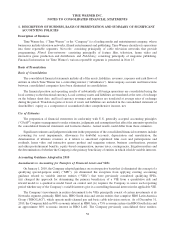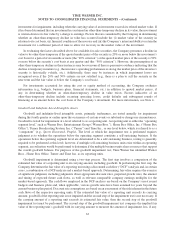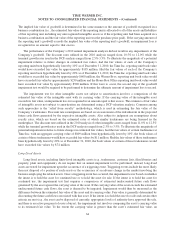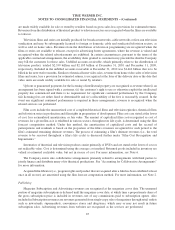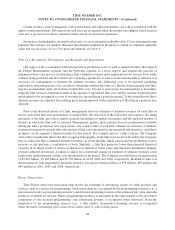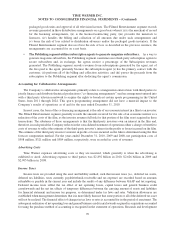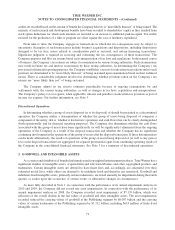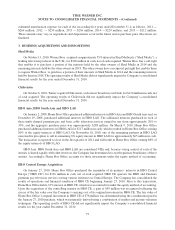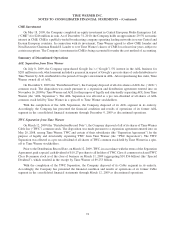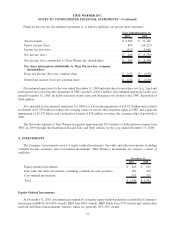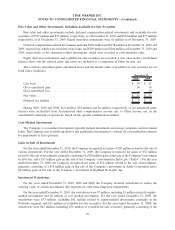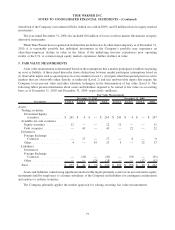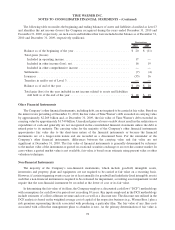Time Magazine 2010 Annual Report Download - page 80
Download and view the complete annual report
Please find page 80 of the 2010 Time Magazine annual report below. You can navigate through the pages in the report by either clicking on the pages listed below, or by using the keyword search tool below to find specific information within the annual report.Certain products, such as magazines sold at newsstands and other merchandise, are sold to customers with the
right to return unsold items. Revenues from such sales are recognized when the products are shipped, based on gross
sales less a provision for future estimated returns based on historical experience.
Inventories of merchandise are stated at the lower of cost or estimated realizable value. Cost is determined using
primarily the average cost method. Returned merchandise included in inventory is valued at estimated realizable
value, but not in excess of cost. For more information, see Note 6.
Film Cost Recognition, Participation and Residuals and Impairments
One aspect of the accounting for film and television production costs, as well as related revenues, that impacts
the Filmed Entertainment segment (and the Networks segment, to a lesser degree) and requires the exercise of
judgment relates to the process of estimating a film’s ultimate revenues and is important for two reasons. First, while
a film is being produced and the related costs are being capitalized, as well as at the time the film is released, it is
necessary for management to estimate the ultimate revenues, less additional costs to be incurred (including
exploitation and participation costs), in order to determine whether the value of a film has been impaired and, thus,
requires an immediate write-off of unrecoverable film costs. Second, it is necessary for management to determine,
using the film forecast computation method, the amount of capitalized film costs and the amount of participations
and residuals to be recognized as costs of revenues for a given film in a particular period. To the extent that the film’s
ultimate revenues are adjusted, the resulting gross margin reported on the exploitation of that film in a period is also
adjusted.
Prior to the theatrical release of a film, management bases its estimates of ultimate revenues for each film on
factors such as the historical performance of similar films, the star power of the lead actors and actresses, the rating
and genre of the film, pre-release market research (including test market screenings) and the expected number of
theaters in which the film will be released. Management updates such estimates based on information available
during the film’s production and, upon release, the actual results of each film. Changes in estimates of ultimate
revenues from period to period affect the amount of film costs amortized in a given period and, therefore, could have
an impact on the segment’s financial results for that period. For example, prior to a film’s release, the Company
often will test market the film to the film’s targeted demographic. If the film is not received favorably, the Company
may (i) reduce the film’s estimated ultimate revenues, (ii) revise the film, which could cause the production costs to
increase or (iii) perform a combination of both. Similarly, a film that generates lower-than-expected theatrical
revenues in its initial weeks of release would have its theatrical, home video and television distribution ultimate
revenues adjusted downward. A failure to adjust for a downward change in estimates of ultimate revenues could
result in the understatement of film costs amortization for the period. The Company recorded film cost amortization
of $3.407 billion, $3.180 billion and $2.796 billion in 2010, 2009 and 2008, respectively. Included in film cost
amortization are film impairments primarily related to pre-release theatrical films of $78 million, $85 million and
$84 million in 2010, 2009 and 2008, respectively.
Barter Transactions
Time Warner enters into transactions that involve the exchange of advertising, in part, for other products and
services, such as a license for programming. Such transactions are recognized by the programming licensee (e.g., a
television network) as programming inventory and deferred advertising revenue at the estimated fair value when the
product is available for telecast. Barter programming inventory is amortized in the same manner as the non-barter
component of the licensed programming, and advertising revenue is recognized when delivered. From the
perspective of the programming licensor (e.g., a film studio), incremental licensing revenue is recognized
when the barter advertising spots received are either used or sold to third parties.
68
TIME WARNER INC.
NOTES TO CONSOLIDATED FINANCIAL STATEMENTS – (Continued)


